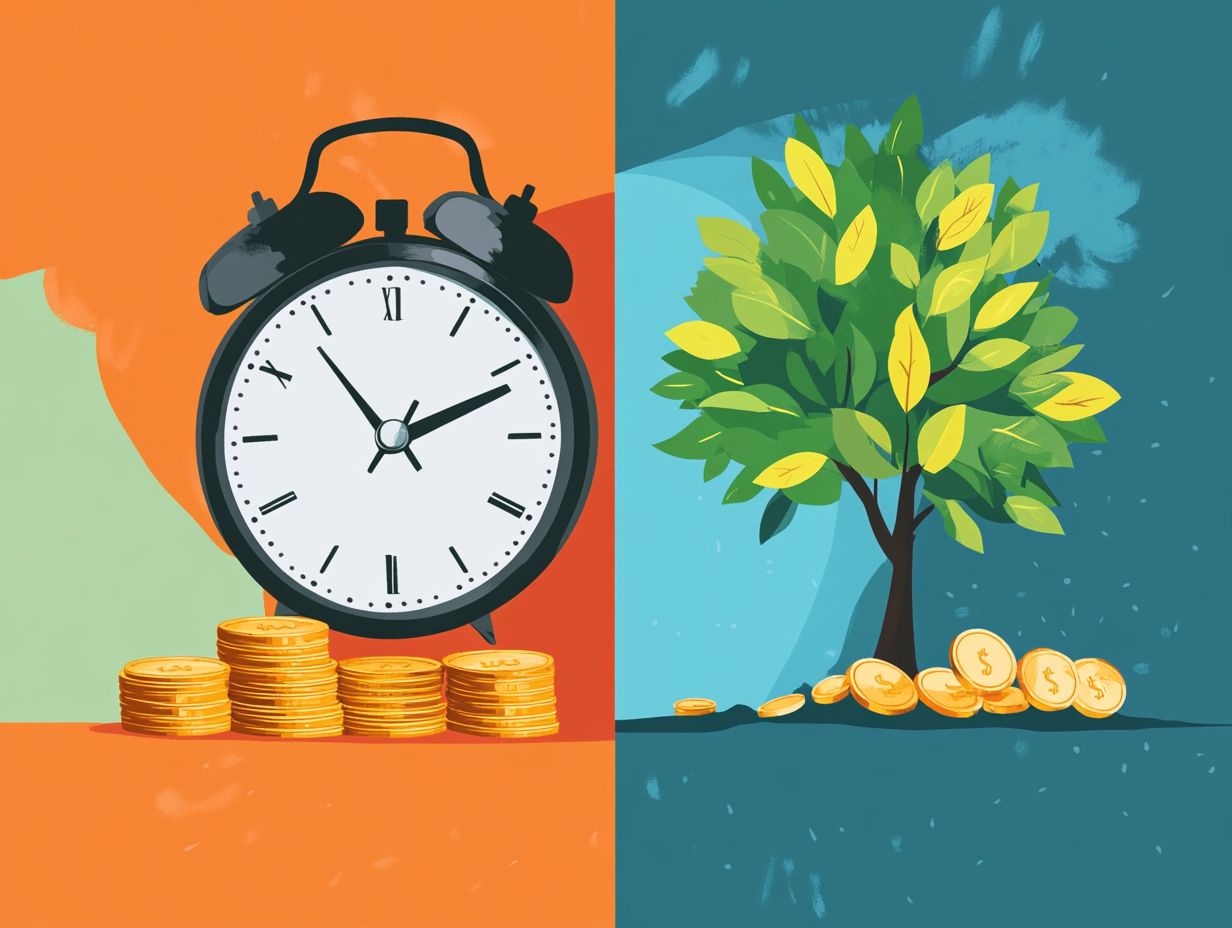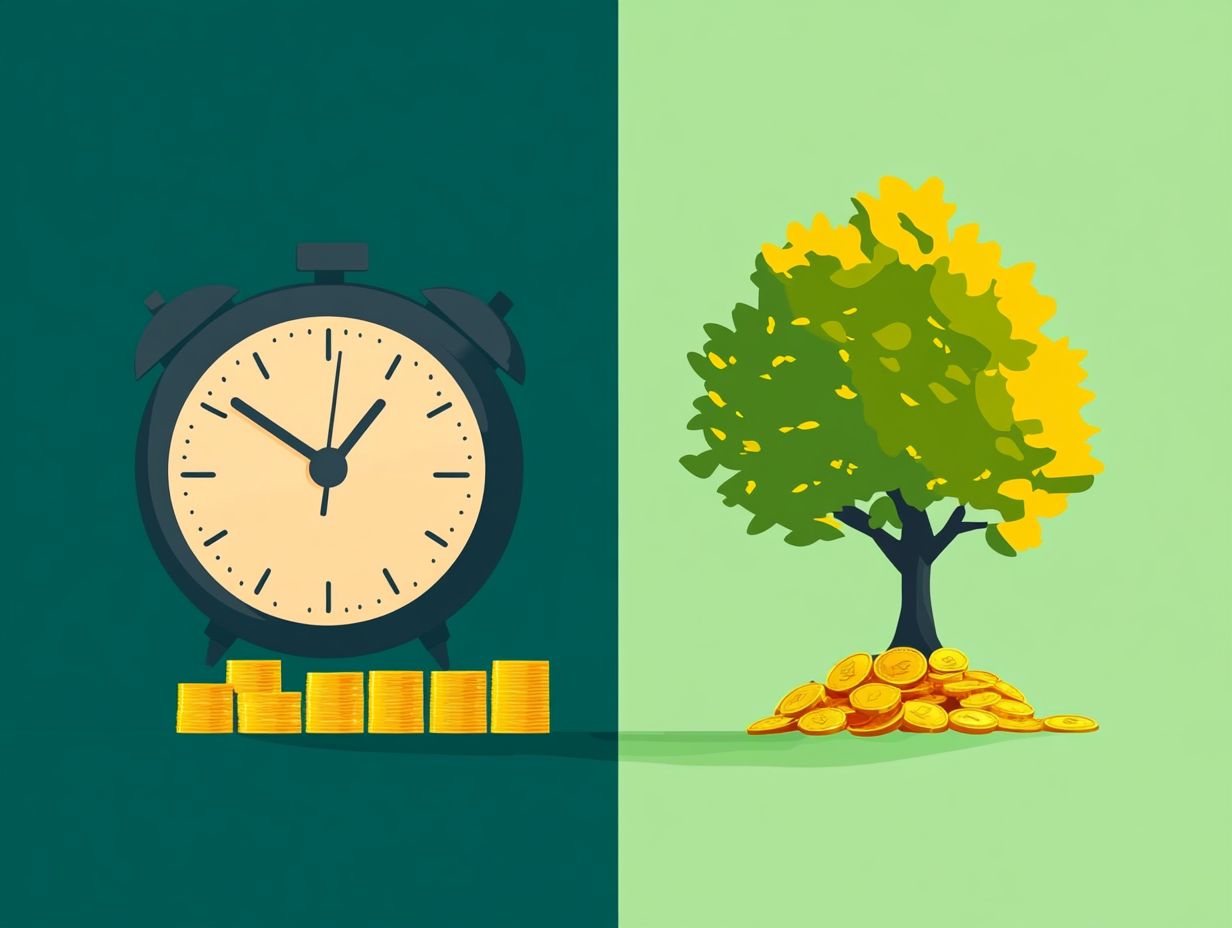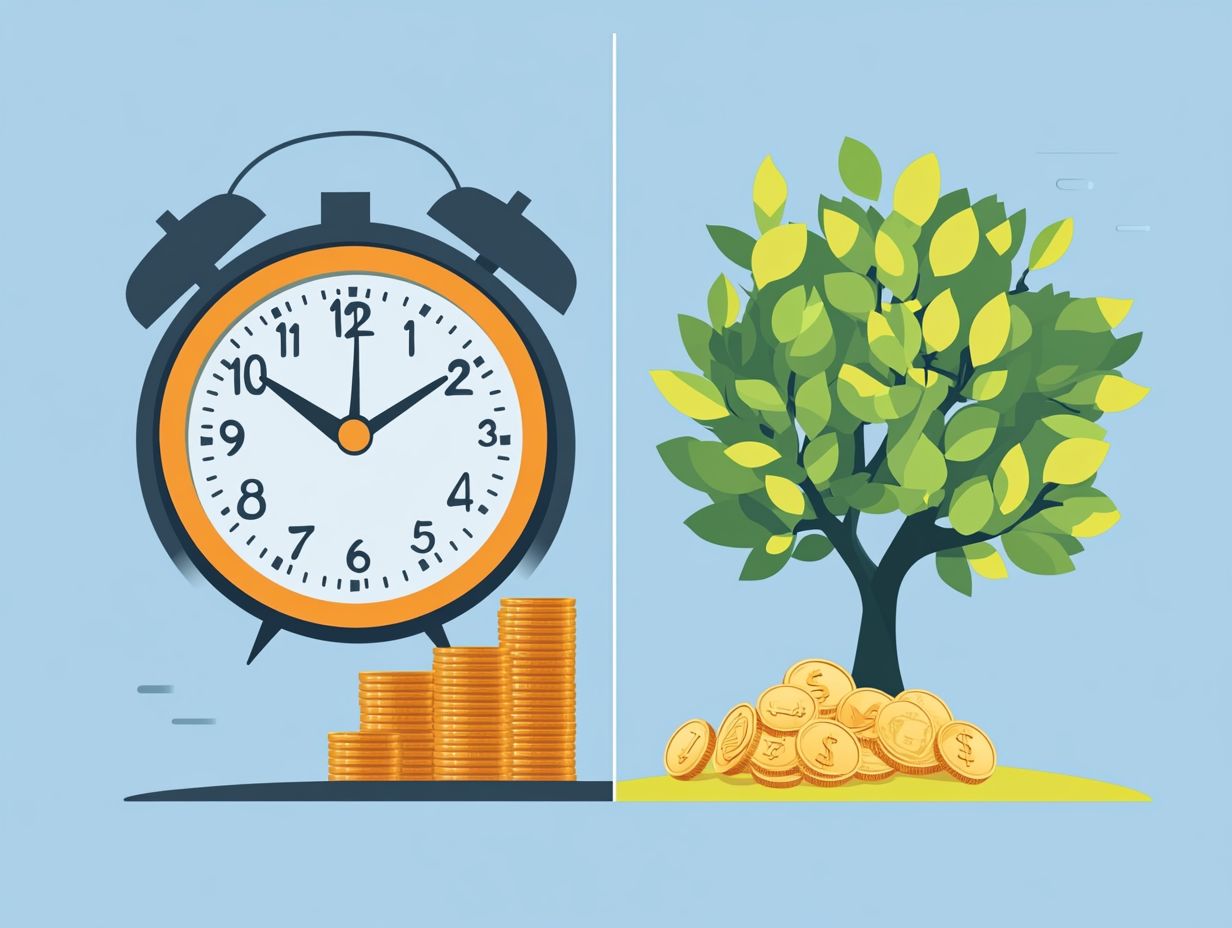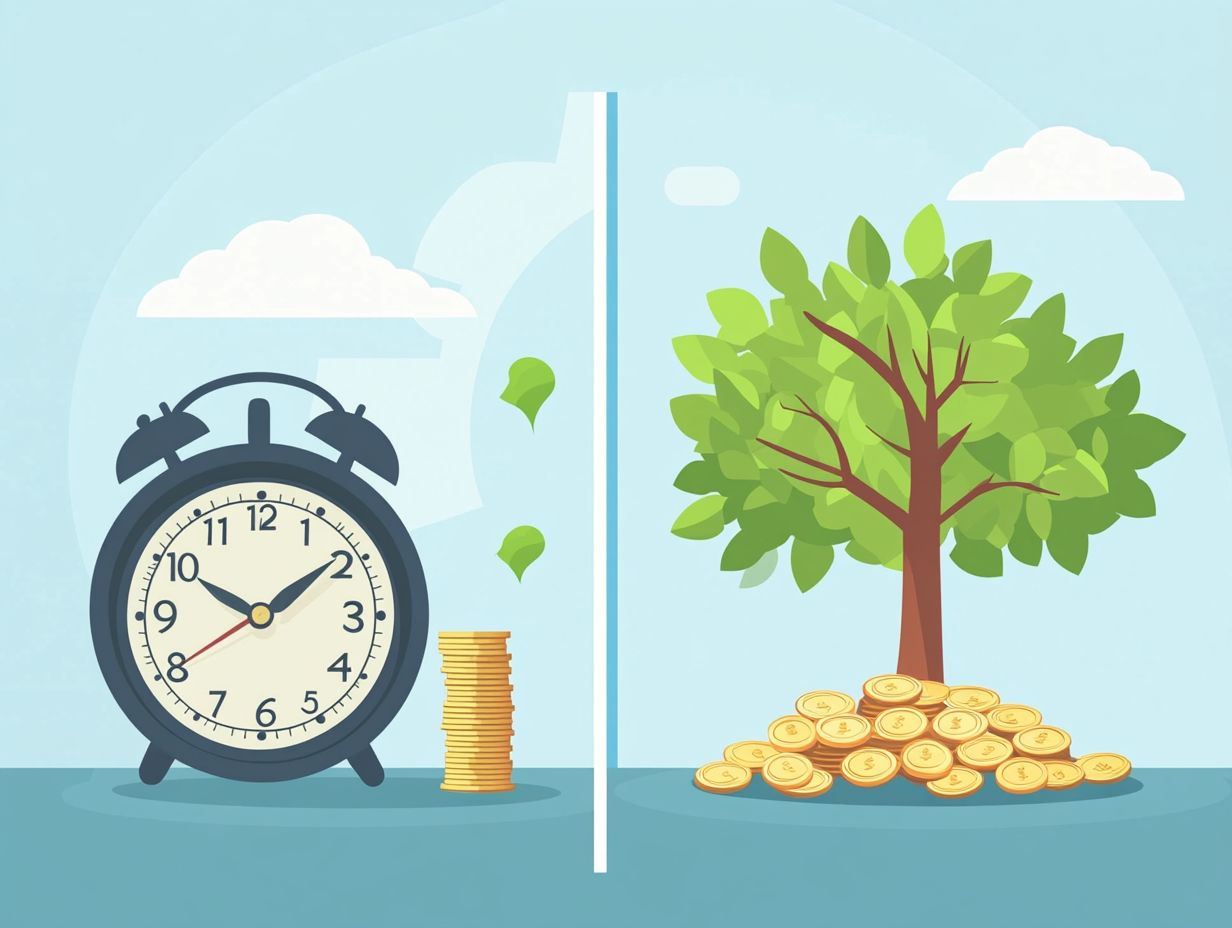What are Short-term vs Long-term Investments?
Investing is an important part of your financial planning journey, yet the terms “short-term” and “long-term” often spark confusion.
Understanding the differences between these two investment strategies is crucial for making informed decisions. This article explains essential concepts such as time horizons, risk and return, and the specific goals tied to each type of investment.
It delves into various examples, evaluates the factors you should consider when choosing your investment path, and weighs the pros and cons of both strategies. By the end, you will have a clearer understanding of how to align your investments with your financial aspirations.
Contents
- Key Takeaways:
- Defining the Terms
- Differences Between Short-term and Long-term Investments
- Types of Short-term and Long-term Investments
- Factors to Consider When Choosing Between Short-term and Long-term Investments
- Pros and Cons of Short-term and Long-term Investments
- Frequently Asked Questions
- What are Short-term vs Long-term Investments?
- What are the benefits of investing in short-term vs long-term investments?
- What are some examples of short-term investments?
- What are some examples of long-term investments?
- What are the risks associated with short-term vs long-term investments?
- Can I have a mix of short-term and long-term investments in my portfolio?
Key Takeaways:

- Short-term investments are typically held for one year or less, while long-term investments are held for a longer period.
- The time horizon, risk and return, and goals differ between short-term and long-term investments.
- When choosing between short-term and long-term investments, consider factors such as your financial situation, market conditions, and investment goals.
Defining the Terms
Capital gains are the profits you earn when your investments increase in value. They fall into two primary categories: long-term capital gains and short-term capital gains. The Internal Revenue Service (IRS) classifies these categories based on how long you’ve held the asset, which affects the tax rates you need to consider in your investment strategy.
Understanding these concepts is key to reaching your wealth objectives and making smart investment choices.
Differences Between Short-term and Long-term Investments
Understanding the distinctions between short-term and long-term investments is crucial for aligning your investment strategy with your financial aspirations. Short-term investments tend to offer quicker returns and are often swayed by market fluctuations. In contrast, long-term investments are held for extended periods to benefit from compound growth and typically involve lower risk over time.
Recognizing these nuances allows you to make informed decisions that resonate with your financial goals.
Time Horizon
The investment horizon is an important factor influencing your choice between short-term gains and long-term wealth, as it indicates how long you plan to hold your assets before needing to access those funds.
Understanding this timeframe is essential as it dictates the types of investments that align with your financial goals. If you re seeking rapid gains, you might be drawn to stocks, capitalizing on market volatility in a short time. Conversely, if you have a longer investment horizon, real estate may appeal to you, offering stable growth and potential passive income over the years.
By understanding how your investment horizon shapes your choices, you can create a more strategic portfolio that aligns with your specific financial objectives and risk tolerance.
Risk and Return
The relationship between risk and return is vital to your investment strategy. Short-term gains often come with higher volatility and risk, while long-term gains generally offer more consistent and stable returns over time.
As an investor, you’ll frequently weigh the immediate rewards of short-term investments like stocks and day trading against the slower, steadier growth of long-term assets such as bonds or real estate.
A savvy trader might profit quickly from market fluctuations, but this strategy can also lead to significant losses if the market declines. On the other hand, investors who prefer long-term investments can weather market storms and benefit from compounding interest, ultimately enjoying a more stable return on their investment.
Understanding these dynamics enables you to choose investment strategies that match your personal financial goals and risk tolerance.
Goals and Objectives

Establishing your financial goals is crucial for your investment decisions. These specific objectives guide you in choosing whether to pursue short-term gains or focus on long-term capital appreciation.
For instance, if you re aiming for a quick return on your investment, you might gravitate towards aggressive short-term trading strategies. This approach emphasizes frequent buying and selling of stocks and carries the potential for higher risks.
On the other hand, if your goal is to build wealth over a longer horizon, you may prefer a more conservative strategy, favoring stable, slower-growing investments.
It s essential to weave an understanding of capital gains taxes into your decision-making process. Short-term profits are generally taxed at a higher rate than long-term gains, which can significantly affect your net earnings. Thus, aligning your investment choices with your financial goals and tax considerations is vital for maximizing your returns.
Types of Short-term and Long-term Investments
Both short-term and long-term investments encompass a diverse array of asset classes, such as stocks, bonds, real estate, and alternative investments. Each of these classes plays a distinct role in enhancing your investment strategy, catering to various financial objectives and timelines.
Examples of Each
Short-term investments include options like stocks traded on the market, bonds with shorter maturities, and high-yield savings accounts. On the other hand, long-term investments typically encompass real estate, precious metals, and collectibles.
Short-term investments are marked by their ease of accessing your money and lower risk, making them perfect for anyone seeking quick gains or setting aside emergency funds. For example, high-yield savings accounts not only provide immediate access to your cash but also offer better interest rates compared to traditional accounts.
Conversely, long-term investments, such as real estate, present opportunities for wealth appreciation while also generating passive income through rental properties. These assets require a patient approach, as their values can fluctuate over time. By understanding the unique characteristics of these asset classes, you can align your investment choices with your financial goals, whether you prioritize immediate returns or sustainable growth.
Factors to Consider When Choosing Between Short-term and Long-term Investments
When deciding between short-term and long-term investments, it’s essential to consider several key factors. Your personal financial situation plays a significant role, as do the current market conditions and your unique investment goals.
Each aspect will help shape your strategy and guide your decisions, ensuring you make informed choices that align with your financial aspirations.
Personal Financial Situation
Your personal financial situation, including your income, assets, and tax brackets, shapes your best investment strategy be it short-term or long-term.
These elements profoundly influence your risk tolerance and liquidity needs, making it crucial to customize your investment approach accordingly. For instance, if you enjoy a higher income, you might feel emboldened to pursue more aggressive strategies aimed at capital appreciation. In contrast, if your income is more modest, you may prioritize stable returns to bolster your cash flow.
Your current investment portfolio also plays a pivotal role in diversification, guiding whether reallocating assets or exploring new opportunities aligns best with your overarching financial objectives.
Understanding your tax liabilities is also important; the implications of capital gains can significantly impact your choices between high-yield investments and those that offer gradual, steady growth, ultimately influencing your overall returns.
Imagine the possibilities! Start planning your investments today!
Market Conditions

Market conditions, which include fluctuations and broad economic trends, play a pivotal role in shaping your investment strategy. They dictate whether short-term or long-term investments are more advantageous at any given moment.
As an investor, you analyze economic indicators such as inflation rates, unemployment figures, and GDP growth. These metrics provide invaluable insights into the economy’s health. For instance, when inflation rises, you might gravitate toward assets like commodities or real estate, which tend to hold their value during turbulent periods.
A stable job market combined with rising consumer spending often leads you to consider growth stocks, driven by the anticipation of higher returns over time.
Recently, volatility in tech stocks due to interest rate hikes has prompted you to pivot your focus toward more defensive sectors, such as utilities and healthcare. This shift highlights your adaptability in the ever-evolving landscape of investment decision-making.
Investment Goals
Clearly defined investment goals are essential for you, guiding your decisions between short-term gains and long-term capital appreciation. This choice significantly impacts your overall financial objectives and potential tax implications.
If you re focusing on growth, you will likely choose stocks or mutual funds that promise appreciation over time, even if they come with higher volatility. Conversely, if you’re aiming for income, you may prefer bonds or dividend-paying stocks, which offer regular cash flows. For those prioritizing capital preservation, conservative options like savings accounts or government bonds are often more suitable.
Understanding how different investment horizons affect your tax liability is crucial. Generally, longer holding periods can reduce the impact of capital gains tax, allowing you to maximize returns without the immediate burden of taxes.
Pros and Cons of Short-term and Long-term Investments
Exploring the pros and cons of short-term and long-term investments reveals vital insights about their unique advantages and disadvantages. This understanding equips you to craft a more effective investment strategy tailored to your goals.
Advantages of Short-term Investments
Short-term investments offer distinct advantages, such as quick returns and high liquidity. However, they come with challenges like increased risk and market volatility.
Disadvantages of Short-term Investments
Short-term strategies, like trading stocks or options, can yield profits within days or even hours. This appeals to those who thrive in fast-paced markets. However, this approach carries significant risk; sudden market shifts can lead to substantial losses, underscoring the necessity of a robust risk management plan.
Advantages of Long-term Investments
On the flip side, long-term investments think real estate or retirement accounts allow your wealth to compound over the years, making them generally more resilient to market fluctuations.
A well-researched stock purchase held for a decade often outperforms day trading, thanks to the magic of compound interest and lower transaction costs.
Disadvantages of Long-term Investments
This contrast highlights the varying strategies investors can adopt based on their individual financial goals and risk tolerance, creating a rich and diverse investment landscape.
Frequently Asked Questions
What are Short-term vs Long-term Investments?

Short-term investments refer to financial assets expected to be held for a short period, usually one year or less. Long-term investments, on the other hand, are assets held for a longer duration, typically more than one year.
What are the benefits of investing in short-term vs long-term investments?
Short-term investments offer quick returns and easy access to cash. They are great for emergency funds or reaching short-term financial goals.
Long-term investments can lead to higher returns and help you achieve big financial dreams.
What are some examples of short-term investments?
Short-term investments include things like savings accounts, certificates of deposit, money market accounts, and short-term bonds.
What are some examples of long-term investments?
Long-term investments can include stocks, real estate, mutual funds, and retirement accounts like 401(k)s and IRAs.
What are the risks associated with short-term vs long-term investments?
Short-term investments tend to be less risky, thanks to their shorter time frame. However, they can still face market fluctuations and inflation risks.
Long-term investments might offer greater rewards but come with higher market volatility. They often require a longer waiting period to see significant returns.
Can I have a mix of short-term and long-term investments in my portfolio?
Yes! A balanced portfolio with both short-term and long-term investments can help manage risks while maximizing returns. Short-term investments provide stability and cash availability, while long-term investments offer growth potential.






